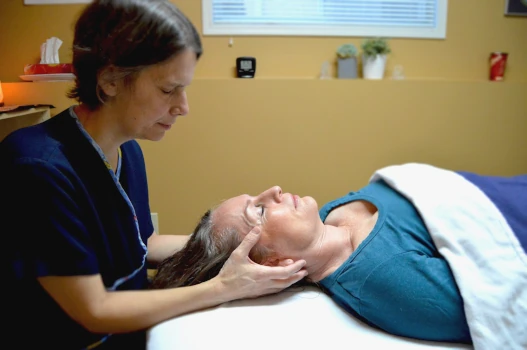Craniosacral Therapy: What It Is and What You Can Expect
Monday, October 04, 2021, 05:05 PM
What is Craniosacral Therapy (CST)?
Craniosacral therapy (CST) involves soft-tissue manipulation techniques that focus on musculoskeletal health and function. CST practitioners use their hands to release built-up tension within the body and fascial tissues.
 Nicole Ainscough, an NHPC member and practising craniosacral therapist, defines craniosacral therapy as "a whole-person approach to healing, which is achieved by acknowledging our physical and emotional interconnectedness."
Nicole Ainscough, an NHPC member and practising craniosacral therapist, defines craniosacral therapy as "a whole-person approach to healing, which is achieved by acknowledging our physical and emotional interconnectedness."
Nicole started as a client of CST and has been practising craniosacral therapy for over 10 years now. "As a client, it changed many old patterns and chronic pain for me," she explains.
"Craniosacral therapists are highly skillful at listening to the body's inherent health mechanisms. The therapist typically looks for and encourages the forces of health to set the priorities of the session, and to bring about natural adjustments from within the body's own resources," Nicole says.
CST practitioners look for subtle movements of the cerebrospinal fluid. They then apply light pressure through specific holding patterns to manipulate the fascial system and the flow of fluid.
Craniosacral therapy can help to relieve pain and tension for many conditions.
Who Can Benefit from Craniosacral Therapy?
People of all backgrounds and ages can benefit from craniosacral therapy. It is a gentle, non-invasive practice appropriate for treating many different symptoms or ailments, particularly ones related to the nervous system.
Nicole sees clients for a variety of reasons. Many clients seek CST to improve their sleep, reduce anxiety, balance their hormones, address symptoms of concussion, or find relief from chronic pain.
Nicole regularly works with clients who are pregnant or have recently given birth. She has found working with both the child-bearer and baby is beneficial to prepare them for labour or to rebalance the body following birth.
Craniosacral therapy may also help individuals that suffer from migraines, fibromyalgia, and multiple sclerosis.
What Can You Expect at Your First Craniosacral Therapy Appointment?
Clients remain fully clothed during a craniosacral therapy appointment. You can expect to be on the treatment table for 45 minutes during a one-hour appointment.
Nicole says, "The remaining time left in the appointment allows us to talk about your expectations and experiences before and after the session."
This open communication between you and your practitioner is also common in massage therapy appointments and many other holistic health practices. You should feel comfortable giving frequent feedback and expressing questions or concerns; this will allow you to fully relax into the treatment.

During the session, the practitioner will place their hands on different parts of your body to feel for pulses of the cerebrospinal fluid and they will then remove any blockages that are present.
"I usually start at the feet, to allow me to tune into the client's entire system," Nicole explains. "After that, I will place my hands lightly at various points on the body to facilitate a reorganizing based on the priority your system expresses."
As CST is a gentle, non-invasive practice, you should not expect to feel any pain during the session, though a mild discomfort may occur as your body responds to the treatment. Clients will leave the treatment with mental clarity and a renewed sense of physical presence.
Interested in trying craniosacral therapy? Visit our Member Directory to find a practitioner in your area.

